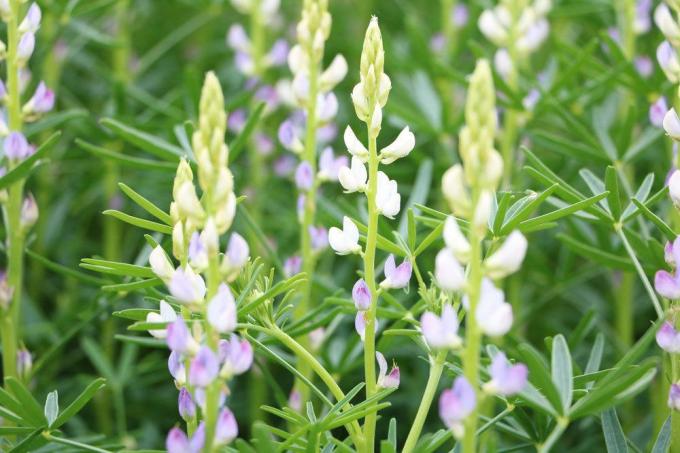
table of contents
- Recognize Lupinus
- Toxicity
- Contained poison
- Poisonous plant parts
- Dangerous for humans and animals
- Poisoning in humans
- Serious poisoning
- Poisoning in animals
- High risk of poisoning
- First aid
- Recommended initial measures
Lupins are very popular because they are modest and easy to care for. In the past, mostly only seen on farms, they have now also moved into German gardens. They impress with their elegant charm and bring color to the garden. However, the perennial with the botanical name Lupinus is said to be poisonous. How it behaves and how dangerous it actually is for humans and animals can be read in the plant guide.
Recognize Lupinus
So that you know whether you should be standing in front of a lupine and, if necessary, exercise caution, because it is poisonous, you should identify the wolf bean, as it is sometimes called can.
Optical features
- Fingered, lanceolate leaves
- colorful flowers
- Height: up to two meters
- Green to gray-green foliage, mostly covered with silvery hairs
- Dense spike or grape blossoms
- Two-lipped calyx
- Legumes with smooth or slightly rough seed kernels are formed
- Generative characteristics
- Grows primarily on sunny, light, slightly loamy soil
- Flowering period: between June and August
- After the flowering period, the seeds develop into early autumn
Toxicity
Are Lupins Poisonous?
The question can be answered with a "conditional". There are numerous types of lupins that have a toxicity that is not found in others. The latter includes, for example, the sweet lupine. This and all other non-toxic Lupinus species are special breeds. In these, the poison was bred from the original plant by removing the bitter substances it contained. These bitter substances contain the poison. Lupine species of these new breeds are also offered for the extraction of protein-rich nutritional elements. The “old” species Lupinus polyphyllos, which blooms blue or yellow, is one of the most poisonous and most widespread species.
Contained poison
The poisonous lupine contains alkaloids. These are substances that develop naturally. The included acotinin leads to a particularly high risk. This is one of the most dangerous plant poisons. It is a neurotoxin and, among other things, has a psychoactive effect. In the worst case, consumption can result in a life-threatening situation that can result in death.
Poisonous plant parts
The wolf bean is not poisonous on all parts of the plant. The toxin is "only" in the Seeds as well as the herbaceous ones Scroll contain. There is no plant poison in the stems, petals or roots. It is contained in the plant sap and enters the body / organism of humans and animals through consumption or mouth contact.
Dangerous for humans and animals
How dangerous poisonous lupins are depends on several factors. The toxicity level varies from species to species. A pest infestation or insects can also increase the poison concentration in the short term. This is the case because the plant wants to protect itself against predators with the poison. If there is a danger from parasites or insects, the poison level increases automatically. When it comes to the amount, the rule of thumb is: the more bitter the taste, the more toxin it contains and more dangerous symptoms of poisoning can occur.
Poisoning in humans
If you or your children accidentally get herbaceous leaves or seeds of a poisonous lupine in their mouth, spitting them out immediately is usually a natural reaction. The bitter taste usually triggers the reflex immediately.
But you can also transfer it into your mouth if you come into contact with the sap. Spitting it out is more difficult here and often too late because even then part of it remains in the mouth and / or is swallowed down. In most cases, however, there are slight symptoms of intoxication, which can be expressed as follows:
- General restlessness
- Paleness of the face
- Sweats
- Slight tremor
- Vomit
Serious poisoning
More serious symptoms of poisoning are to be expected if poisonous parts of the plant have been swallowed. Children in particular are particularly at risk here because the small body has not yet developed a robust, strong immune system.
The most poisonous are the seeds. Even a fruit with seeds can be life-threatening and lead to death. The first signs are expressed, as already mentioned, and further dangerous reactions of the body can also be triggered:
- Cardiac arrhythmias
- cramps
- Signs of paralysis
- Apnea
- Cardiac arrest
- Poisoning in animals
Poisoning in animals
In principle, wild animals tolerate alkaloids and are not exposed to a health hazard by eating lupins. This is different for small and large animals such as dogs, cats, guinea pigs, horses, cows, sheep and birds.
High risk of poisoning
These animals are according to the Information center against poisoning in Bonn significantly more often affected by sometimes strong poisoning reactions. This is also where most of the deaths occur, because in many cases the eating of lupins is not observed and, accordingly, no quick countermeasures can be initiated. The risk of life threatening is particularly high for grazing animals and pets that have longer unattended in the garden with access to the Lupinus.
For this reason, you should suspect poisoning in the event of the following signs, so that, ideally, you can react in good time:
- Increased panting in dogs and cats
- Horses, cows, sheep, etc. show noises when breathing
- Colic is noticeable by rolling and kicking under the stomach
- Increased saliva discharge
- Faster, shallow breathing, which can be recognized by rapid abdominal bulges
- Slowed pupillary response
- If it comes to paralysis, the animal remains lying and can no longer be got up
- Cardiac arrhythmias
Can lead to death:
- Shallow breathing with impending respiratory arrest after symptoms of paralysis
- Cardiac arrest

First aid
In any case, if there is a suspicion of mouth contact and, above all, if it has been done Contact an (emergency) doctor / veterinarian if poisonous plant parts are swallowed from the lupine set. From this you will learn in detail what you can take as the first effective measure. You should have information ready for the doctor / veterinarian that will enable him to better assess the health hazard situation. You should be able to answer the following questions as information for the interview, if possible:
- How long ago was the contact / consumption?
- What and how much was swallowed?
- Have the first symptoms of intoxication occurred?
- How quickly does the condition of the affected person / animal worsen?
- Did you vomit?
Recommended initial measures
In general, you can counteract internal poisoning with charcoal tablets and a lot of water or at least minimize the possible consequences of poisoning.
By drinking plenty of water, the plant poison is swiftly washed out of the stomach into the intestines. There, the charcoal tablets ensure that they bind quickly. In this way, less toxin gets into the bloodstream and can cause less damage in the human and animal body.
Definitely not milk
In the event of poisoning, milk must not be given, as is often suggested as advice. Milk contains substances that quickly get into the bloodstream and take the toxins with them on their journey. So with milk you can accelerate the symptoms of poisoning and make them worse.
Remove poisonous part of the plant
If you have a poisonous plant part in your mouth and already started swallowing, stop it Swallowing process immediately and carefully remove it with a suitable "tool" such as a Tweezers. If you have noticed the consumption in children or animals, you should also check here whether you can still access the plant part in the upper throat area for removal without any problems.
If the part of the plant is already deeper, only a doctor can with the help of certain medical treatments Instruments remove the poisonous foreign body if it has not yet been decomposed by the gastric acid became.
Do not force vomiting
It is important that you do not induce vomiting under any circumstances, as this could lead to serious damage to the esophagus and, in the worst case, cause asphyxiation.
Note: Please note that this article does not in any way replace a visit to the doctor. There is no guarantee that medical statements are correct.
You will find detailed information on first aid in the event of poisoning and important information on poison control centers here.





